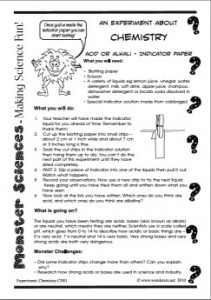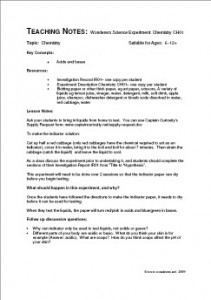This experiment requires a little bit of preparation, but it is really worth it to see the look of total surprise and amazement on your student’s face when they watch the indicator change colour on different substances!
 |
 |
Chemistry Science Experiment: Acid or Alkali – Make your own indicator paper
What you will need:
- Blotting paper
- Scissors
- A variety of liquids eg lemon juice, vinegar, water, detergent, milk, soft drink, apple juice, shampoo, dishwasher detergent or bicarb soda dissolved in water
- Special indicator solution made from cabbages!
What you will do:
1 Your teacher will have made the indicator liquid for you ahead of time. Remember to thank them!
2 Cut up the blotting paper into small strips – about 2 cm or 1 inch wide and about 7 cm or 3 inches long is fine.
3 Soak the cut strips in the indicator solution then hang them up to dry. You can’t do the next part of this experiment until they have dried completely.
4 PART 2: Dip a piece of indicator into one of the liquids then pull it out. Watch what happens.
5 Record your observations. Now use a new strip to try the next liquid. Keep going until you have tried them all and written down what you have seen.
6 Now look at the lists you have written. Which ones do you think are acid, and which ones do you think are alkaline?
What is going on?
The liquids you have been testing are acids, bases (also known as alkalis) or are neutral, which means they are neither. Scientists use a scale called pH, which goes from 0 to 14 to describe how acidic or basic things are – 0 is very acid, 7 is neutral and 14 is very basic. Very strong bases and very strong acids are both very dangerous.
Monster Challenges:
- Did some indicator strips change more than others? Can you explain why?
- Research how strong acids or bases are used in science and industry.
Teaching Notes: Chemistry CH01
Topic:
Chemistry Suitable for Ages: 6 -12+
Key Concepts:
Acids and bases
Resources:
Investigation Record IR01– one copy per student
- Experiment Description Chemistry CH01– one copy per student
- Blotting paper or other thick paper, eg art paper, scissors, A variety of liquids eg lemon juice, vinegar, water, detergent, milk, soft drink, apple juice, shampoo, dishwasher detergent or bicarb soda dissolved in water, red cabbage, water
Lesson Notes:
Ask your students to bring in liquids from home to test. You can use Captain Curiosity’s Supply Request form: www.captaincuriosity.net/supply-request.doc
To make the indicator solution:
Cut up half a red cabbage (only red cabbages have the chemical required to act as an indicator), cover it in water, bring it to the boil and boil for about 7 minutes. Then strain the cabbage (catch the liquid!) and leave the liquid to cool.
As a class discuss the experiment prior to undertaking it, and students should complete the sections of their Investigation Report IR01 from ”Title to “Hypothesis”.
This experiment will need to be done over 2 sessions so that the indicator paper can dry before you begin testing.
What should happen in this experiment, and why?
Once the students have followed the directions to make the indicator paper, it needs to dry before it can be used for testing.
When they test the liquids, the paper will turn red/pink in acids and blue/green in bases.
Follow up discussion questions:
- Why can indicator only be used to test liquids, not solids or gases?
- Different parts of your body are acidic or basic. What do you think your skin is for example (Answer: acidic). What are soaps? How do you think soaps affect the pH of your skin?



